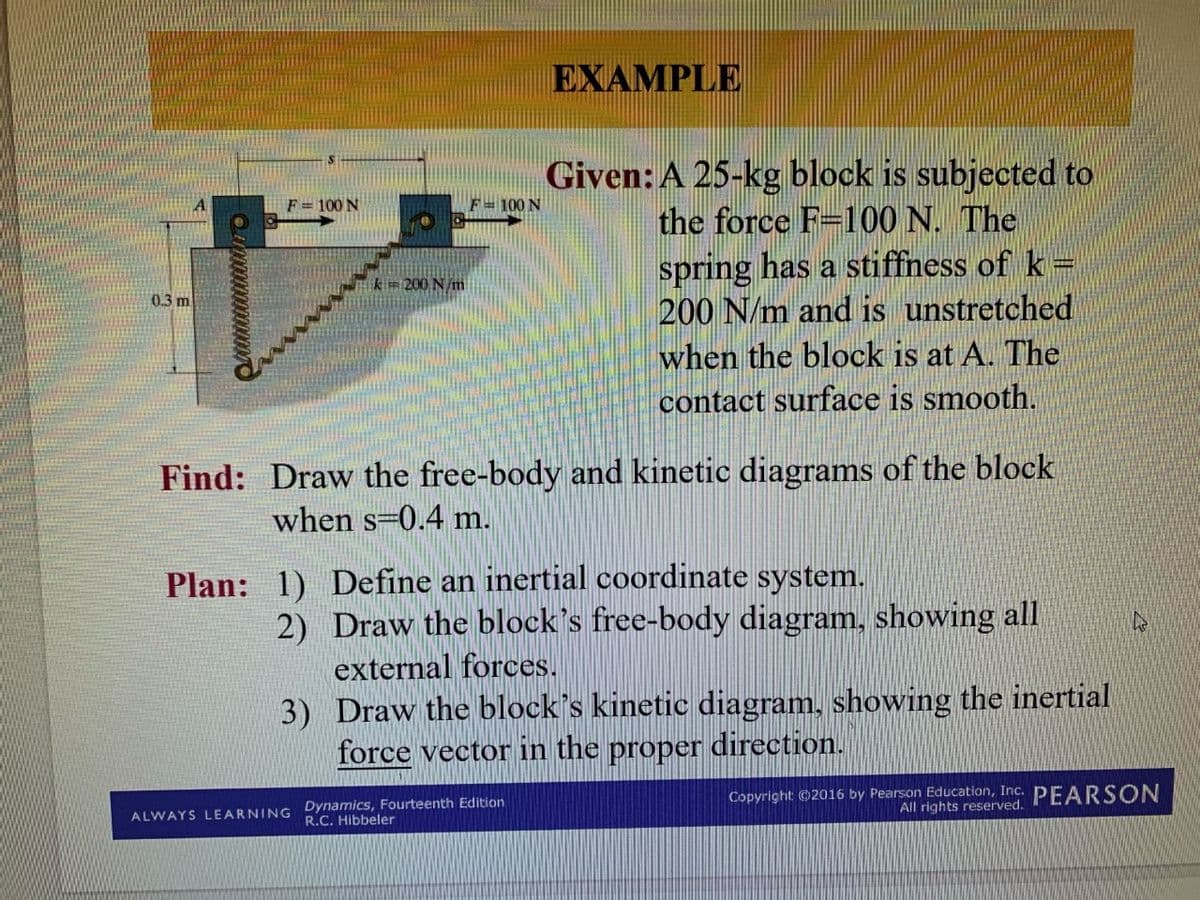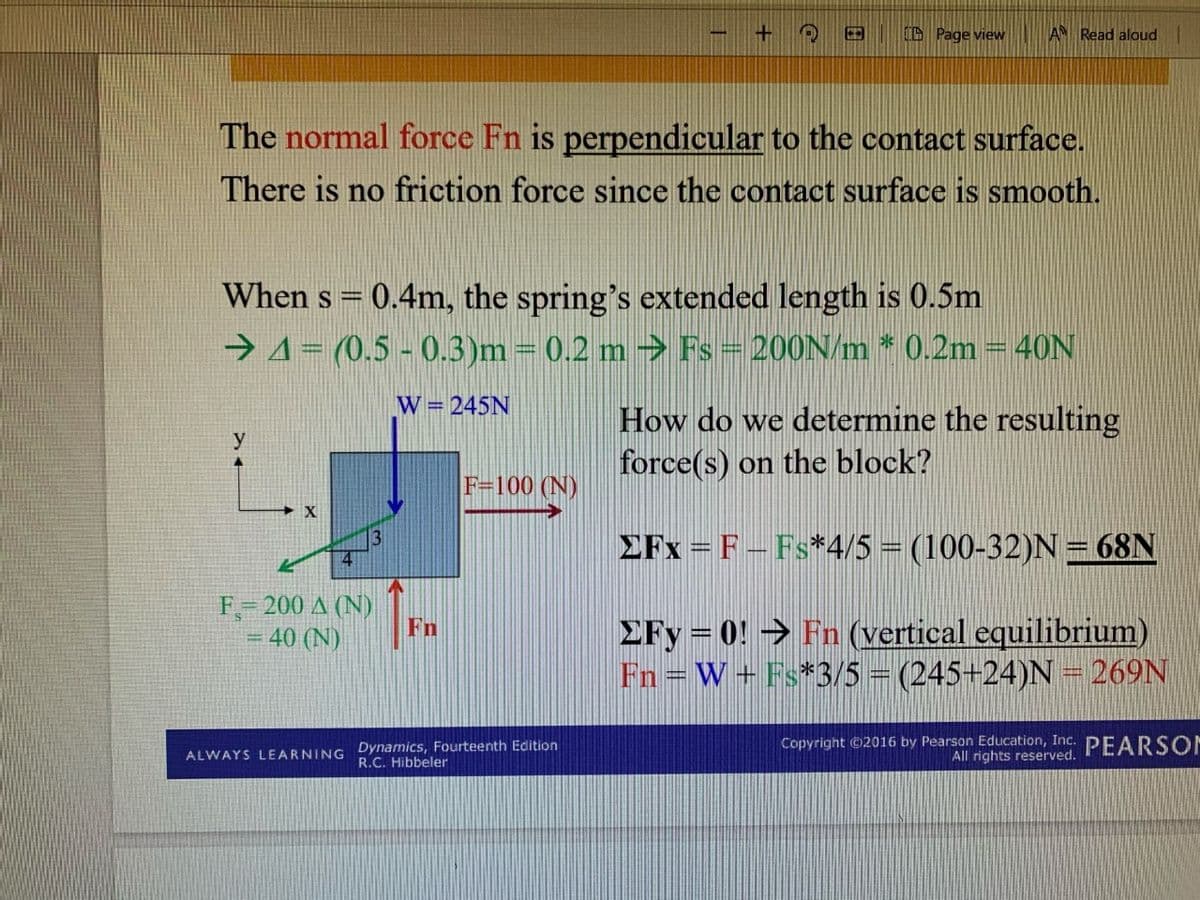Given: A 25-kg block is subjected to the force F=100 N. The F= 100 N F= 100 N spring has a stiffness of k = 200 N/m and is unstretched 200 N/m 0.3 m when the block is at A. The contact surface is smooth. Find: Draw the free-body and kinetic diagrams of the block when s-0.4 m. Plan: 1) Define an inertial coordinate system. 2) Draw the block's free-body diagram, showing all external forces. 3) Draw the block's kinetic diagram, showing the inertial force vector in the proper direction.
Given: A 25-kg block is subjected to the force F=100 N. The F= 100 N F= 100 N spring has a stiffness of k = 200 N/m and is unstretched 200 N/m 0.3 m when the block is at A. The contact surface is smooth. Find: Draw the free-body and kinetic diagrams of the block when s-0.4 m. Plan: 1) Define an inertial coordinate system. 2) Draw the block's free-body diagram, showing all external forces. 3) Draw the block's kinetic diagram, showing the inertial force vector in the proper direction.
Principles of Physics: A Calculus-Based Text
5th Edition
ISBN:9781133104261
Author:Raymond A. Serway, John W. Jewett
Publisher:Raymond A. Serway, John W. Jewett
Chapter7: Conservation Of Energy
Section: Chapter Questions
Problem 15P: A block of mass m = 2.00 kg is attached to a spring of force constant k = 500 N/m as shown in Figure...
Related questions
Question
eep moving to the right, since the net force to
the right is 68N >0.
The acceleration could be directed to the right if the block is
speeding up or to the left if it is slowing down.
- Is the block accelerating or decelerating?
“Homework”: - What is the equation for Fx(s)?
- What is the maximum distance, smax?

Transcribed Image Text:EXAMPLE
Given: A 25-kg block is subjected to
F= 100 N
F= 100 N
the force F=100 N. The
spring has a stiffness of k=
200 N/m and is unstretched
200 N/m
0.3 m
when the block is at A. The
contact surface is smooth.
Find: Draw the free-body and kinetic diagrams of the block
when s-0.4 m.
Plan: 1) Define an inertial coordinate system.
2) Draw the block's free-body diagram, showing all
external forces.
3) Draw the block's kinetic diagram, showing the inertial
force vector in the proper
direction.
ALWAYS LEARNING Dynamics, Fourteenth Edition
R.C. Hibbeler
Copyright ©2016 by Pearson Education, Inc. PEARSON
All rights reserved.

Transcribed Image Text:CD Page view
AN Read aloud
The normal force Fn is perpendicular to the contact surface.
There is no friction force since the contact surface is smooth.
When s = 0.4m, the spring's extended length is 0.5m
→4= (0,5 - 0.3)m = 0.2 m → Fs = 200N/m * 0.2m = 40N
W = 245N
How do we determine the resulting
force(s) on the block?
y
F=100 (N)
EFx = F – Fs*4/5 = (100-32)N= 68N
F- 200 A (N)
Fn
40 (N)
£Fy = 0! → Fn (vertical equilibrium)
Fn = W+ Fs*3/5 = (245+24)N = 269N
ALWAYS LEARNING Dynamics, Fourteenth Edition
R.C. Hibbeler
Copyright ©2016 by Pearson Education, Inc. PEARSON
All rights reserved.
Expert Solution
This question has been solved!
Explore an expertly crafted, step-by-step solution for a thorough understanding of key concepts.
This is a popular solution!
Trending now
This is a popular solution!
Step by step
Solved in 4 steps with 5 images

Knowledge Booster
Learn more about
Need a deep-dive on the concept behind this application? Look no further. Learn more about this topic, physics and related others by exploring similar questions and additional content below.Recommended textbooks for you

Principles of Physics: A Calculus-Based Text
Physics
ISBN:
9781133104261
Author:
Raymond A. Serway, John W. Jewett
Publisher:
Cengage Learning

Physics for Scientists and Engineers with Modern …
Physics
ISBN:
9781337553292
Author:
Raymond A. Serway, John W. Jewett
Publisher:
Cengage Learning

College Physics
Physics
ISBN:
9781305952300
Author:
Raymond A. Serway, Chris Vuille
Publisher:
Cengage Learning

Principles of Physics: A Calculus-Based Text
Physics
ISBN:
9781133104261
Author:
Raymond A. Serway, John W. Jewett
Publisher:
Cengage Learning

Physics for Scientists and Engineers with Modern …
Physics
ISBN:
9781337553292
Author:
Raymond A. Serway, John W. Jewett
Publisher:
Cengage Learning

College Physics
Physics
ISBN:
9781305952300
Author:
Raymond A. Serway, Chris Vuille
Publisher:
Cengage Learning

Physics for Scientists and Engineers: Foundations…
Physics
ISBN:
9781133939146
Author:
Katz, Debora M.
Publisher:
Cengage Learning

Physics for Scientists and Engineers
Physics
ISBN:
9781337553278
Author:
Raymond A. Serway, John W. Jewett
Publisher:
Cengage Learning

College Physics
Physics
ISBN:
9781285737027
Author:
Raymond A. Serway, Chris Vuille
Publisher:
Cengage Learning